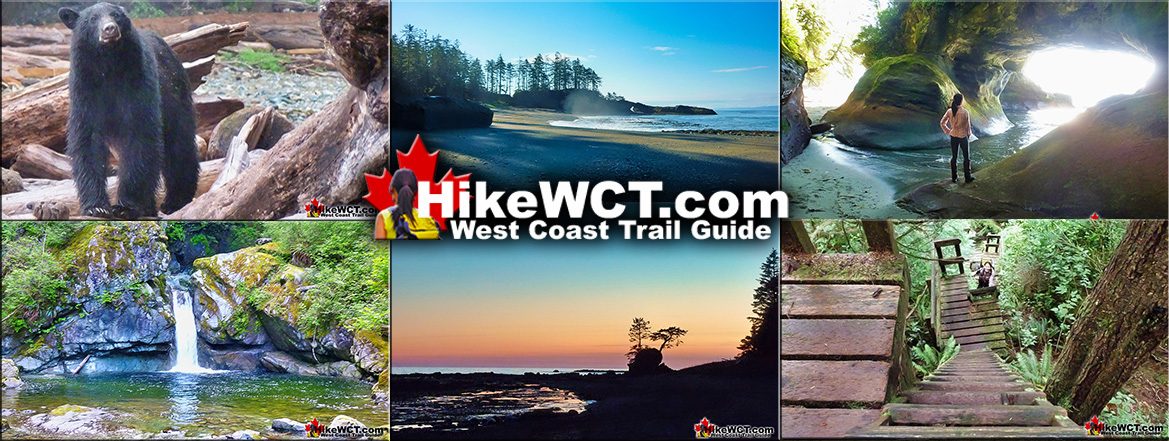![]() There were just 38 survivors of the Valencia shipwreck. An estimated 140 people lost their lives on the ship over the course of 36 hours. The 38 survivors escaped the ship at different times and different ways. Nine of the survivors managed to make it through the first hour when all but one of the lifeboats were flipped in the surf or smashed against the ship. These wet and freezing survivors gathered along the base of cliffs about 250 metres north of the Valencia.
There were just 38 survivors of the Valencia shipwreck. An estimated 140 people lost their lives on the ship over the course of 36 hours. The 38 survivors escaped the ship at different times and different ways. Nine of the survivors managed to make it through the first hour when all but one of the lifeboats were flipped in the surf or smashed against the ship. These wet and freezing survivors gathered along the base of cliffs about 250 metres north of the Valencia.
The Valencia Disaster
![]() 1. The Valencia
1. The Valencia ![]() 2. The Voyage
2. The Voyage ![]() 3. The Boats
3. The Boats ![]() 4. The McCarthy Boat
4. The McCarthy Boat ![]() 5. The Bunker Party
5. The Bunker Party ![]() 6. On the Valencia
6. On the Valencia ![]() 7. The Rafts
7. The Rafts ![]() 8. The Turret Raft
8. The Turret Raft ![]() 9. The Rescue Ships
9. The Rescue Ships ![]() 10. The Aftermath
10. The Aftermath ![]() 11. The Survivors
11. The Survivors ![]() 12. The Lost
12. The Lost
The West Coast Trail
![]() Prologue
Prologue ![]() 1: The West Coast Trail
1: The West Coast Trail ![]() 2: When to Hike & Fees
2: When to Hike & Fees ![]() 3: Trailheads
3: Trailheads ![]() 4: Getting There
4: Getting There ![]() 5: Considerations
5: Considerations ![]() 6: Campsites
6: Campsites ![]() 7: Shipwrecks
7: Shipwrecks ![]() 8: Routes
8: Routes ![]() 9: Sights & Highlights
9: Sights & Highlights
In the morning they managed to climb to the top of the cliff where they entered the forest where they discovered a telegraph wire strung between trees. They followed the wire through the near impenetrable forest until they reached a lineman's hut. This group of men became known as the Bunker Party after Frank Bunker, who took charge when they set off from the cliffs. Another group of survivors left the ship the following morning on the last lifeboat, boat No.5. Boatswain McCarthy was first to volunteer to get on the boat and five others volunteered after him. The McCarthy Boat was ordered to get to land near the ship and hike up to the cliffs opposite and receive a line shot from the Valencia. They failed to get to shore anywhere close to the ship and ended up landing several miles north of the Valencia near the Cape Beale Lighthouse. These six survived and reported the Valencia shipwreck to the world, though the Bunker Party had already done so an hour earlier. The following day at about 930am, Wednesday January 24th, 1906, rescue ships would finally arrive. Due to the stormy weather, they remained barely within sight of the Valencia which was being battered by huge waves and breaking apart. About 90 wet and freezing survivors clung to the Valencia and with the ships seemingly unwilling to help, they chose to launch the two remaining life rafts. The design of the rafts meant that the occupants would be constantly drenched with water and be hard to maneuver in the rough seas. Getting away from the ship seemed unlikely. Sometime between 10am-1030am ten brave men went off on the first raft and got away from the ship remarkably easily. Seeing the success of the first raft, the second raft was overloaded with 19 men and also cleared the breakers. Both rafts soon lost sight of each other and drifted apart. The ships they were hoping to reach had actually departed and another ship, the Topeka did not know the location of the Valencia and was searching up and down the coast. Two freezing and terrifying hours would pass before the second raft was finally spotted by the Topeka and brought on board. The nineteen barely alive survivors of the Topeka Raft asked about the first raft which was not so lucky. The ten on board the first raft was reduced to just four survivors when one by one they would succumb to the freezing cold of being partly submerged on the raft. Twenty six hours after they first left the Valencia, three of the survivors were found on Turret Island where they managed to land about fourteen hours into their ordeal. The fourth man was located the following day.
Topeka Raft Nineteen Survivors
 1. Cornelius Allison
1. Cornelius Allison
Cornelius Allison was a first-class passenger and one of the 38 survivors of the Valencia shipwreck. In his sixties at the time, Allison was a former sailor with significant maritime experience, which shaped his perspective and actions during the ordeal. He was among the 19 survivors rescued from the second life raft, known as the Topeka Raft, by the SS City of Topeka. Allison provided detailed testimony during the Seattle investigation into the disaster, offering insights from his background as a seasoned sailor. He described the surf that destroyed the Valencia as not particularly high, suggesting his familiarity with stormy seas allowed him to remain composed. He criticized the rescue ships, particularly noting that a vessel he believed to be the Queen steamed away without attempting a rescue. Allison recalled the dire conditions on the raft, stating, “It was terrible on the raft, the water was awfully cold. Our limbs became so benumbed that we could not even move them sufficiently to keep ourselves warm. I thought all would die of exposure.” More...
 2. Thomas Carrick
2. Thomas Carrick
Thomas Carrick, the first assistant engineer on the Valencia survived on the second raft picked up by the Topeka. In the chaotic first hour of the wreck, Carrick was in charge of the No.7 lifeboat. Timothy McCarthy, boatswain on the Valencia recalled, “No.7 was a wrecking boat and was small. She was in charge of assistant engineer Carrick. As she was lowered, one end became unfastened, and the people in her were spilled into the sea, all losing their lives except Carrick, who was pulled on board by his shipmates.” The Valencia wrecked just before midnight on Monday, January 22nd. About 34 hours later, at 10am Wednesday morning the situation on the Valencia was horrific. Battered by waves, the ship was breaking apart and sinking lower into the crashing ocean. Rescue ships had appeared in the distance, however no attempt at rescue had been made. Knowing the ship could collapse under the waves at any moment, the crew decided to launch the last two life rafts. More...
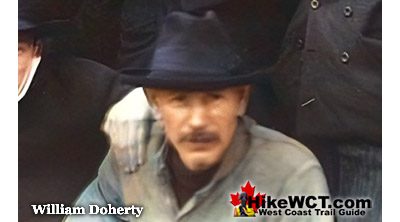 3. William Doherty
3. William Doherty
William Doherty, a 40-year-old fireman with 22 years of experience on steamships, was one of the nineteen survivors rescued by the steamship Topeka. His account sheds light on the chaos and survival efforts during the catastrophe. Doherty was in the engine room when the Valencia struck a reef, causing water to flood the fore part of the ship. He and his crewmates worked desperately to maintain steam pressure as the order came for “full speed astern,” prompting the ship to reverse rapidly. Doherty survived by escaping on the second and final life raft launched from the Valencia. Most of the nineteen men that crowded onto it had to jump from the Valencia into the ocean and swim to it, starting their journey already dangerously cold. Submerged up to their knees they frantically paddled through the breakers and out to sea toward the Queen which departed before they could reach it. More...
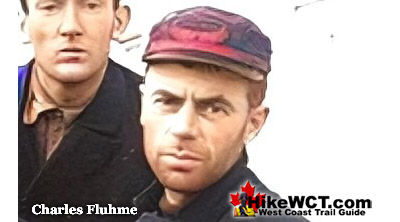 4. Charles Fluhme
4. Charles Fluhme
Charles Fluhme was a baker on the Valencia who survived with eighteen others crowded on the last raft that left the Valencia. From Germany he came to the United States a few years ago and started a baking business in Phoenix. He recently moved to San Francisco and has worked for the Pacific Coast Steamship Company for about a year. He was reportedly warned by his friend to not sail on the Valencia, but Fluhme laughed off the superstitious warning. Fluhme is rarely mentioned in reports of the Valencia disaster and his time on the Valencia and the second liferaft rescued by the City of Topeka is only known from other survivors. They survived the intense cold on the partly submerged raft for four hours. Some were nearly dead when the Topeka picked them up and could not have survived much longer. More...
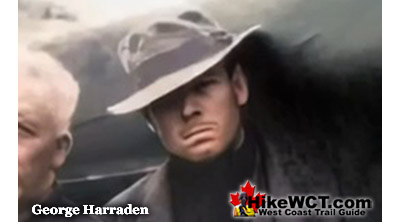 5. George Harraden
5. George Harraden
George Harraden, a first-class passenger on the Valencia that escaped on the raft picked up by the Topeka. His name is spelled different in almost every newspaper reporting on the Valencia. Variously spelled Haradan, Harradon and Harriden to name a few. In an interview in the days following the Valencia disaster Harraden recalled sending his mother off on what was likely lifeboat No.1. He got away on the second raft which was rescued by the Topeka. Harraden heard someone tell the lady passengers before the raft was launched that it was their last chance, but did not hear any reply. He did not see anyone jump overboard and miss the raft. They had a hard time getting away from the ship. He could not say if it would be successful or not, but it was worth trying. On the raft, after they lost sight of the Queen, they turned back towards the land and then sighted the Topeka; she picked them up, and he was just about “all in.” More...
 6. A.H. Hawkins
6. A.H. Hawkins
A.H. Hawkins was a second-class passenger on the Valencia and one of the nineteen survivors picked up 36 hours into the disaster by the City of Topeka. Very little is known about him before or after the Valencia disaster, though his experience during the disaster was well reported. He gave detailed interviews which were reported in newspapers. The Vancouver Daily Province wrote, "AH Hawkins whose knees were severely bruised, as he was thrown about the deck like a puppet. Hawkins was so exhausted and suffered so much from shock that his speech halted, and he could hardly utter a word. At times he would stop in his limping walk, gaze abstractedly at the pavement and become entirely oblivious to his surroundings, as he evidently reviewed in his mind the agony of the shipwreck." He also testified in the Valencia Inquiry in Seattle which paints a picture of the horrific events that he went through and managed to survive. More...
7. Charles Hoddinott
Charles P. Hoddinott was a waiter on the Valencia who survived on the last life raft to leave the ship. Charles Hoddinott was the brother of the ship's chief steward Jack Hoddinott, who drowned in the wreck. The chief steward refused a spot on the last life raft, insisting on staying behind to assist the women and children. Charles reportedly urged his brother to join him, but Jack declined, saying, "I am going to stand by the women and children." Charles then bid him goodbye and jumped overboard to escape. Charles Hoddinott was among those who made it onto the last life raft carrying 14 crew members and 5 passengers. Launching the raft took about 45 minutes amid the chaos. This group was eventually picked up by the rescue steamer SS City of Topeka, which also learned from them about another raft adrift and remaining people on the Valencia. More...
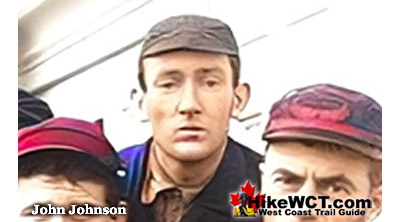 8. John Johnson
8. John Johnson
John Johnson third cook on the Valencia who was one of the nineteen liferaft survivors that were saved by the City of Topeka. Nineteen year-old Johnson lived in San Francisco and had recently transferred to the Valencia from the Roanoake. Johnson described his departure on the life raft, “We got away from the ship’s side without mishap, which is a miracle to me. I did not have much hope of life when I started to let myself down on that raft. I took one of the oars, and this, I think, helped me considerably to keep my blood in circulation and warm, as I was in my bare feet, with only a thin shirt and pair of trousers on.” After two agonizing hours the City of Topeka, a steamer searching the coast was spotted. The men rowed with desperate strength, waving a shirt tied to a boat hook to signal the ship. Initially, the Topeka seemed to turn away, plunging the survivors into despair. But then it approached, and a rescue boat was launched. More...
 9. W.D. Johnson
9. W.D. Johnson
W.D. Johnson was a coal passer on the Valencia who survived on the Topeka Raft. Little is known about him beyond newspaper reports of him being one of the survivors picked up by the City of Topeka. Newspaper reports also list him as one of the survivors that arrived in Seattle. Conditions on the Topeka Raft were nightmarish. Carrick described the survivors standing waist-deep in freezing water, battered by waves, and unable to use the oars effectively. The men improvised, using oars as paddles while forming human “row-locks” to brace each other. Passenger Cornelius Allison recalled, “The water was so cold our limbs became numb. Huge seas buried us, and we choked on saltwater while trying to breathe.” After hours of exposure, some men began to lose their sanity, “blubbering” or “frothing at the mouth,” as Carrick described. McCaffrey observed, “If we had been on that raft an hour longer, every man would have gone insane.” More...
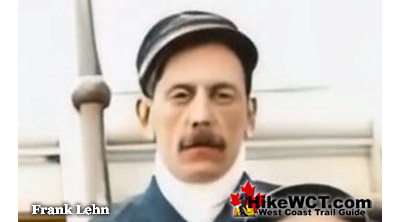 10. Frank Lehn
10. Frank Lehn
Frank Lehn was the first assistant freight clerk on the Valencia who survived on the Topeka Raft. When the second life raft was prepared and he had jumped for it when he felt the steamer’s deckhouse being washed away. Frank Lehn recalled in an interview, that on the raft passengers held on to the life lines on the raft, which had practically submerged. He did not believe that assistance could have been rendered by boats from the Queen or other rescue steamers. Assistance could only come from the shore. The Queen looked to be about three miles away. He remembered seeing Miss Van Wyck, a heavily built lady and her daughter, a little boy of about 7 years and several members of the crew of the Valencia when he left on the raft. The Valencia was about a ship’s length from the shore he said. He remembered the gun being fired three times when the rescue steamers hove in sight, but no discussion as to the method of being rescued. More...
 11. Joseph McCaffrey
11. Joseph McCaffrey
Joseph McCaffrey was a second-class passenger on the Valencia and one of the Topeka Raft survivors. McCaffrey, age 23 was from St. John New Brunswick and departed his home town in November to seek his fortune in the West. His story was extensively covered in newspapers and he testified in both the Canadian and American Valencia inquiries. His time on the life raft was described in dramatic detail in the San Francisco Examiner on January 27th, 1906: “If we had been an hour longer on that raft I believe every man would have gone insane. One could tell by the looks in the eyes of his companions that reason was departing. Just touch some of the men and they would growl like some trapped animals. I pulled on one of the oars with a poor fellow whose strength was about exhausted. He would work like mad for a few moments and then his head would drop on his breast and his hands would relax their grasp.” More...
 12. Patrick O'Brien
12. Patrick O'Brien
Patrick O'Brien was a waiter on the Valencia and one of the nineteen survivors rescued by the City of Topeka. Very little is known about him and he is rarely mentioned in newspapers and seems to have never been interviewed. His photo appears in a few newspapers, but nothing about him. We can only piece together his time on the Valencia from the experiences of other survivors. By 9 a.m. on Wednesday, January 24, after nearly 34 hours of relentless pounding by the Pacific waves, the ship was disintegrating. O'Brien and 80 survivors clung desperately to the few remaining sections of the upper deck still above water, battered by crashing waves that threatened to sweep them away at any moment. Rescue ships appeared on the horizon, raising hopes among the survivors. The Queen, a large steamer, was the first to arrive, followed by the tug Czar and the salvage vessel Salvor. However, no rescue attempts were made. More...
 13. Peter Peterson
13. Peter Peterson
Peter Peterson was the second officer on the Valencia and one of the Topeka Raft survivors. He played a significant role in the events that unfolded during the 37-hour ordeal, which claimed an estimated 136 lives, leaving only 38 survivors. Peterson was an experienced sailor, having run the San Francisco to Seattle route over 100 times, including as second mate on the City of Puebla, the ship the Valencia was temporarily replacing. The Valencia struck the reef just before midnight on January 22, 1906. By Wednesday morning, January 24, with the ship disintegrating, only two life rafts remained. Peterson was among the 19 men who boarded the second raft, later known as the "Topeka Raft," which was spotted by the steamship City of Topeka after two hours at sea. The raft was then boarded by anyone brave enough to leap from the ship into the churning ocean and climb aboard. More...
 14. Paul Primer
14. Paul Primer
Paul Primer was a fireman on the Valencia who survived on the Topeka Raft. He had worked for the Pacific Coast Steamship Company for the last year. His name appears in newspapers in a variety of ways such as P. Poivner, P. Reimer and even T. Palmer. It appears that Paul Primer is the correct spelling as the San Francisco Examiner copied P. Primer, 26 Essex Street, San Francisco from the phone book. Also, the San Francisco Chronicle printed a photo of him as well as other survivors. His name was printed as Paul Primer and the names of the other survivors were spelled correctly. Primer's experience is only vaguely reported in newspapers at the time, so details of the events shown here are from other survivors. The Valencia wrecked just before midnight on Monday, January 22nd, 1906. Nearly 34 hours later, at 9am Wednesday morning the situation on the Valencia was horrific. Battered by waves, the ship was breaking apart and settling lower with every crashing wave that slammed into her. More...
 15. Walter Raymond
15. Walter Raymond
Walter Raymond was a messman on the Valencia and one of the 38 survivors of the Valencia disaster. After nearly 34 hours clinging to the disintegrating ship amid battering waves, Raymond escaped on the second life raft, later dubbed the Topeka Raft. Two rafts were launched out of desperation, as a last resort when rescue ships failed to approach. He nearly drowned jumping for it, recalling: “I made a jump for the raft, and it seemed to me I would never again reach the top of the water. I had just sense enough left to not breathe and all the time my lungs kept paining until I thought they would break. Everything got black to me... when, all of the sudden I popped up into the air... I looked for the raft and it was fully fifty feet from me. I gave up then... I was lifted by a gigantic wave and fiercely hurled through the air. I landed squarely on top of the boys on the raft and they grabbed me. I know no more until I found myself being hauled aboard the Topeka." More...
 16. John Segalos
16. John Segalos
John Segalos was a fireman on the Valencia and one of the survivors of the Valencia disaster. Segalos survived by escaping on the Topeka Raft, one of two life rafts that carried survivors to safety. The Topeka Raft, picked up by the SS City of Topeka on January 24, 1906, carried 19 men, including Segalos, who endured brutal conditions—freezing, battered by waves, and nearly insane from exposure. Segalos bravely attempted a heroic act by volunteering to swim to shore with a rope to secure a lifeline for a breeches buoy, a rescue device. He struggled against powerful undertows, became entangled in the rope, and was hit by a log, forcing him to cut the line and return to the ship. He would later recall, "I volunteered to try to swim to land. A rope was secured to me and I plunged into the surf. It was no use, I was simply dashed back by the waves and so I cut the line and a life buoy was thrown to me and I was pulled aboard stunned." More...
 17. Martin Tarpey
17. Martin Tarpey
Martin Tarpey was a quartermaster on the Valencia and one of the Topeka Raft survivors. Born around 1882, he began his maritime career in 1903 as a sailor with the Pacific Coast Steamship Company, advancing to quartermaster by 1906. In that role, he served aboard the Valencia during its disastrous final voyage from San Francisco to Seattle It was Tarpey's first trip north on the vessel. Early reports listed him as one of the lost, however The Call newspaper later reported: “M. Tarpey, quartermaster, boards at 709 Davis street, and there he has made many friends. The house was in gloom over his death. The Call representative changed gloom to gladness when he told of Tarpey's safety.” He testified at both the Canadian and United States Valencia Inquiries where he recounted his story which started off horrifically with the lowering of the No.1 boat he was in charge of. “After 25 or 30 people entered, overloading her. Something carried away and all were thrown into the sea and all but two were lost.” More...
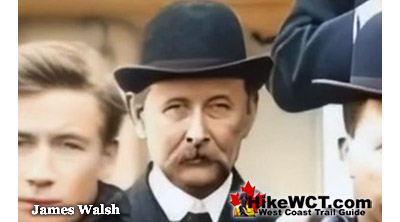 18. James Walsh
18. James Walsh
James Walsh was a waiter on the Valencia who survived on the Topeka Raft. He lived in San Francisco with his parents, bother and sisters. He had been working with the Pacific Coast Steamship Company for several years. Walsh was first reported as missing and his family grieved for two days until they received a wire from him to tell them he was alive and had been rescued on a life raft. He was briefly interviewed in newspapers where he reported that if they were not found by the Topeka, they would all have been corpses in two hours. “..for they had been drenched to the skin and exposed to the gale and the billows for forty-eight hours.” He praised Captain Johnson and was adamant that the Captain did not order the catastrophic launching of the lifeboats after the ship struck. He charged that the passengers became panic stricken and piled into the lifeboats and frantically cut the ropes dumping themselves into the sea. More...
 19. Grant L. Willitts
19. Grant L. Willitts
Grant L. Willitts, a passenger on the Valencia that survived on the second raft, the last raft to depart the Valencia. About two hours after they departed, the Valencia collapsed into the sea killing everyone still on board. Willitts and 18 others on the overcrowded, partly submerged raft were rescued by the City of Topeka. Barely alive, they were brought on board the Topeka and reported the situation on the Valencia when they left her. His recollection of the events on the Valencia are terrifyingly vivid: "Every wave washed clear over her and many people who hastily rushed on deck went to their death without time to murmur a prayer. The order was given to get out the boats. Two of them on the weather side were launched and were smashed like eggshells as soon as they struck the water. Then came the attempt to get out the lee boats. Purser O’Farrell took charge; four women and a number of men went into the boat. I do not know how many, but she was practically full." More...
Bunker Party Nine Survivors
 1. Frank Bunker
1. Frank Bunker
Frank Bunker was a first-class passenger on the Valencia who survived in the shore party that he led and became known as the Bunker Party. Frank Bunker was on lifeboat No.6 with his wife, 4 year old daughter Dorothy, 2 year old son Frank, fireman Frank Richley and four others. He recalled after the boat he was in was launched and they got away from the side of the steamer they had no difficulty in navigating into the open sea despite the cold, dark and stormy weather. They managed to get a couple hundred yards from the Valencia before being caught by a breaker and casting most on board into the freezing ocean. Frank Bunker, his wife and son managed to survive, though Dorothy was never seen again. Moments later the boat, caught in another breaker was thrown again. More...
 2. Frank J. Campbell
2. Frank J. Campbell
Frank J. Campbell was a second class passenger on the Valencia who survived with the Bunker Party. Prior to the voyage, Campbell worked as an agent for the Metropolitan Life Insurance Company in Alameda, California. He was traveling to Seattle with his wife and 16-year-old stepdaughter to establish a machine business. During the shipwreck, Campbell boarded lifeboat No. 3—the fifth boat launched from the Valencia—which carried 15 people. The boat briefly escaped the ship's vicinity but lost an oar, causing it to veer into breakers and capsize, resulting in the drowning of eight occupants, including Campbell's wife and stepdaughter. Campbell was one of seven men who survived the capsizing and reached shore at the base of steep cliffs approximately 250 meters north of the wreck site. The other survivors from his boat were Tony Brown, George Billikos, Yosuki Hosoda, Mike Stone, Charles Samuels, and Albert Willis. More...
 3. Albert Willis
3. Albert Willis
Albert Willis was a 17-year-old United States Navy seaman and second-class passenger aboard the Valencia. He had recently completed his naval training in Pensacola, Florida, and was en route to join his assignment on the USS Philadelphia, which was anchored in Bremerton, Washington. There were several other men from the US navy on the Valencia and Willis may have been travelling with or at least acquainted with some of them. Willis reported that seaman Clyde William Knight was on the Valencia, though not registered on board. This was later confirmed by the navy along with the other men who did not survive. Ordinary Seaman John Finley, Coal Passer Harman Fisher, Ordinary Seaman Clyde William Knight, Ordinary Seaman Charles Uhler and Coal Passer John Sidney Widmer. In the frantic and chaotic first hour after the Valencia struck, Willis boarded the No. 3 lifeboat, carrying 15 people. More...
 4. Charles Samuels
4. Charles Samuels
Charles Samuels was a first class passenger on the Valencia who survived with the Bunker Party. During the chaos following the wreck, Samuels escaped on lifeboat No. 3—the fifth boat launched—which carried 15 people but quickly lost an oar, veered into the surf, and capsized, drowning eight occupants. Samuels and six other men (Frank J. Campbell, Tony Brown, George Billikos, Yosuki Hosoda, Mike Stone, and Albert Willis) managed to swim or drift to shore, landing at the base of near-vertical cliffs about 250 meters (820 feet) north of the Valencia wreckage. They were soon joined by two more survivors (Frank Bunker and Frank Richley) from the capsized lifeboat No. 6, forming a group of nine known as the "Bunker Party." Soaking wet and freezing in the January cold, the men huddled together on the rocky beach overnight for warmth. More...
 5. Tony Brown
5. Tony Brown
Tony Brown was an Austrian second-class passenger on the Valencia on his way to Seattle. Travelling with his friend and fellow Austrian Mike Stone, they were among the nine men who survived the initial launching of lifeboats in the first hour of the disaster. Just after midnight in stormy weather with freezing rain falling, lifeboat No.3 was launched into the darkness between violent, crashing waves and sheer cliffs. Tony Brown, Mike Stone and five others would somehow survive by clinging to the base of a cliff and crawling above the crashing waves. Eight others from boat No.3 drowned and disappeared into the darkness. They were soon joined by two survivors from another lifeboat, Frank Bunker and Frank Richley. This group of nine, later dubbed the “Bunker Party” huddled together at the base of a cliff under freezing rain until dawn. More...
 6. Mike Stone
6. Mike Stone
Mike Stone was an unregistered Valencia passenger on the Valencia who survived in the Bunker Party. He left the Valencia in the first hour after the wreck on the No.3 lifeboat, the fifth boat launched and managed to get away from the Valencia for a short distance with fifteen people on board. After one of the oars was lost, the boat veered towards the surf and flipped over, drowning eight. Somehow Mike Stone and six other men survived and ended up along the shore at the base of a near vertical cliff about 250 metres north of the Valencia. With Mike Stone were Frank Campbell, Tony Brown, Yosuki Hosoda, George Billikos, Charles Samuels, Albert Willis and Frank Bunker and Frank Richley from the No.6 lifeboat. These nine men huddled together, soaking wet and freezing at the base of the cliff until daylight. More...
 7. Frank Richley
7. Frank Richley
Frank Ritchley was a fireman on the Valencia who survived with the Bunker Party. In an interview after the wreck he recalled, “I got on board No.6 by climbing over the rail before it was lowered. There were nine men and a woman and children. Could not say how many passengers of this number. There was a mast, sail and oars in my boat. Mr. Bunker and his wife were on board. We were in the boat about 30 minutes. Could not say how many oars were in use. We were trying to keep her head to sea. The current carried us right into shore. We were capsized and righted up. I only saw Mr. and Mrs. Bunker at that time. She was in the boat and Mr. Bunker assisted me in. A few minutes after she capsized again in the surf and hit the rocks, throwing us all out. The side of the boat was smashed in. I climbed up on the shore where Bunker, Campbell, a coal passer, Willis, Tony Brown and two other members of the crew were assembled. Some had reached the shore from other boats or were washed up.” More...
 8. George Billikos
8. George Billikos
George Billikos was a fireman on the Valencia that survived as part of the Bunker Party. His name was hilariously misspelled in newspaper reports as B.E. Ledhos and several other imaginative spellings. He left the Valencia in the first hour after the wreck on the No.3 lifeboat, the fifth boat launched and managed to get away from the Valencia for a short distance with fifteen people on board. After one of the oars was lost, the boat veered towards the surf and flipped over, drowning eight. Somehow George Billikos and six other men survived and ended up along the shore at the base of a near vertical cliff about 250 metres north of the Valencia. With George Billikos were Frank Campbell, Tony Brown, Yosuki Hosoda, Mike Stone, Charles Samuels, and Albert Willis. More...
 9. Yosuki Hosoda
9. Yosuki Hosoda
Yosuki Hosoda was a Japanese second-class passenger on the Valencia who survived in the Bunker Party. He was one of the survivors that reached shore from lifeboat No.3 during the first horrific hour after the Valencia struck. He was travelling with two other Japanese men, T. Manwakio and S. Rancuna, who did not survive and were possibly on lifeboat No.3 with Hosoda.. Owing to Hosoda's poor command of English, he appears to have not been interviewed or called to testify after the Valencia disaster. He was heralded as a hero in one article in The Seattle Post Intelligencer on January 30th, 1906. “Out of the thirteen men in the boat, Hosoda was the coolest, and was the only one to render me any assistance in caring for my wife and daughter.” Said F.J. Campbell. “He kept his head when others in the lifeboat lost all sense and reason. He had the good sense to assist in keeping the lifeboat away from the side of the Valencia when she was being lowered, and it was largely due to his work that the boat was not crushed and all hands lost before we made a start for the shore.” More...
McCarthy Boat Six Survivors
 1. Timothy McCarthy
1. Timothy McCarthy
Timothy McCarthy was the boatswain on the Valencia and survived on the last lifeboat, the No.5 boat launched the morning after the wreck, that became known as the McCarthy Boat. McCarthy hailed from Gloucester, Massachusetts, a prominent fishing port, where he grew up fishing in local waters. He had more than 15 years of seafaring experience by the time of the Valencia voyage, having worked on various steamboats and steamers. The Valencia journey in January 1906 was only his second outing on that particular vessel. Contemporary descriptions portray him as wiry, of average height, confident, and respected by the crew for his leadership and seamanship skills. By the morning of January 23, with the ship disintegrating Captain Johnson ordered McCarthy to assemble a volunteer crew for the last remaining lifeboat (referred to as No. 5 or the "McCarthy Boat"). More...
 2. Charles Brown
2. Charles Brown
Charles Brown, a seaman on the Valencia was one of the six crewmen that left the Valencia in the last lifeboat, the McCarthy Boat, the morning after the shipwreck. The McCarthy Boat left the Valencia at about 9am on Tuesday, January 23rd. They were specifically ordered by the captain to get to land as soon as possible and hike up to the cliffs opposite the ship to receive the line from the Valencia. They did not attempt to reach land until they found an easy landing seven miles north of the Valencia, near the Cape Beale Lighthouse. When asked about this while testifying during a Valencia inquiry, he responded, “I didn’t want to come back’. The Seattle Star printed a picture of the McCarthy Boat survivors on 27 January 1906 and they identify the man in the back row in the middle as Charles Brown. More...
 3. William Gosling
3. William Gosling
William Gosling was a seaman on the Valencia who survived on the McCarthy Boat. The morning after the Valencia wrecked, the one remaining lifeboat was successfully launched with six volunteer crewmen under the command of boatswain Timothy McCarthy. The goal of the McCarthy Boat was to get to shore and make their way up to the cliff above the ship. The Valencia had a Lyle gun capable of firing a rope to the top of the cliff where a boatswain’s chair could be rigged to transport everyone off the ship. Owing to the stormy weather, bad visibility, strong current and it seems, an overpowering fear of crossing the breakers to reach shore, the boat would travel several kilometers down the coast before reaching land near the Cape Beale Lighthouse. They would get to the lighthouse and contact the outside world for help one hour after the Bunker Party did. Gosling is pictured here, in a photo that appeared in the Seattle Star on 27 January 1906. More...
 4. Tom Lampson
4. Tom Lampson
Tom Lampson was a sailor on the Valencia who survived on the McCarthy Boat. His name is misspelled in almost every mention of him in newspapers after the disaster. He is H. Lemsen, T. Lamson and T. Lawson to name just a few. His photo appears in a couple newspapers. The Seattle Star on January 27th, 1906 has him in a group photo with Timothy McCarthy, Charles Brown, Thomas Shields and William Gosling. The San Francisco Examiner on January 29th, 1906 has a photo of him and Timothy McCarthy and John Marks. Sometime after 8am on Tuesday morning, January 23rd, the captain decided to launch the last lifeboat, the No.5 with a crew of men to find a way to land on shore and hike up to the cliffs opposite the ship. The Valencia was equipped with a Lyle gun which fired harpoons up to 1500 feet with a rope attached. If someone could receive the rope, they could pull it up and it would be connected to a heavy rope.. More...
 5. John Marks
5. John Marks
John Marks was a sailor on the Valencia survived on the McCarthy Boat. His name is misspelled in a variety of ways in newspaper reports, as Jack Marks and in the same paper as John Monk and John Mark. Marks had been taking soundings up to fifteen minutes before the vessel struck. He last reported twenty-six fathoms of water. When, with a terrible crash, the ship went on the rocks, Marks says he rushed to the bridge, where he found Captain Johnson giving orders to back the vessel off. All was excitement. Many of the passengers came on deck undressed. Life-preservers were obtained, and those on the ship assembled on the deck. It was first thought the Valencia had run too close into the Cape, and was on Umatilla Reef. It is doubtful if Captain Johnson knew until the following day that he was fully fifty miles out of his course. Sadly, a year after the Valencia wreck he died on another ship. More...
 6. Thomas Shields
6. Thomas Shields
Thomas Shields was a sailor on the Valencia who survived on the last lifeboat (No. 5) to leave the ship. It was launched from the Valencia on the morning of January 23, 1906, around 9am. This lifeboat, under the command of Boatswain Timothy McCarthy and later dubbed the McCarthy Boat, was crewed by Shields and four other sailors, Charles Brown, Tom Lampson, William Gosling, and John Marks. Their mission was to reach shore near the ship, hike to the cliffs opposite, and receive a line shot from the Valencia’s Lyle gun to facilitate a rescue. However, due to foggy weather and fear of navigating the breakers, the McCarthy Boat traveled several miles north, landing near the Cape Beale Lighthouse, about seven miles from the wreck. From there, the group hiked for two hours to the lighthouse, where they reported the disaster to the outside world, though another group, the Bunker Party, had already done so an hour earlier. More...
Turret Raft Four Survivors
 1. Frank Connors
1. Frank Connors
Frank Connors was a waiter on the Valencia and only one of four men that miraculously survived on the Turret Raft. The first of two life rafts, which could hold 18 people, departed Wednesday morning, the 24th of January, with only 10 on board as everyone else was afraid to get on and many expected rescue to come quickly now that a ship had arrived. Not only was there hope for rescue, but the difficulty of actually getting on one of the rafts deterred all but these ten men. The rafts had to be kept away from the side of the Valencia in order to keep it from slamming into it. To get on the raft you had to jump from the ship into the freezing ocean surging in and out and crashing all around. If you do get on a raft you will be freezing cold, soaking wet and constantly hit by waves coming over the sides. Frank Connors dove into the water from the maintopmast to try to catch the first raft as it was leaving and smashed his face on something underwater. When he surfaced he was pulled onto the raft bleeding from his nose and mouth. This raft would wander up the coast, pulled by the current for hours. More...
 2. Samuel Hancock
2. Samuel Hancock
Samuel Hancock was the chief cook on the Valencia and survived on the life raft that reached Turret Island. Later dubbed the Turret Raft, Hancock was just one of four survivors out of the ten men that set off from the first of two rafts that left the Valencia just two hours before it collapsed into the sea. The Seattle Post Intelligencer interviewed Hancock when he reached Seattle and reported: “Of the ten men who left the Valencia on the life raft, one died from exposure less than two hours after the raft left the ship, and five others went violently insane before reaching Turret Island. Twenty-nine hours without food or water, a part of the time washed by the waves which swept over the life raft and pierced by the cold wind and icy sleet, the sufferings of the four men who survived the awful hardships were beyond description. More...
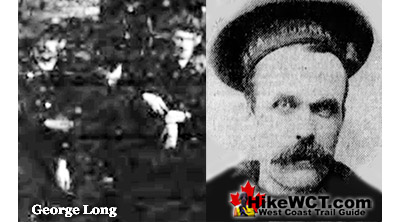 3. George Long
3. George Long
George Long was a fireman on the Valencia who survived on the Turret Raft. Long was an Irishman and had been working on ships all around the world for 16 years. He home was in San Francisco and reportedly took the place of P. Delhanty as a fireman on the Valencia just a few hours before sailing. George Long and chief cook Sam Hancock, waiter Frank Connors and fireman Max Stensler miraculously survived the horrific time on the first of the two life rafts launched from the Valencia at about 10am on Wednesday, January 24th. Thirty-four hours had passed since the Valencia first wrecked. They frantically paddled toward the rescue ship, the Queen which lay less than 2 miles out to sea. The first raft had only 10 men on board as everyone else was afraid to get on and expected rescue to come quickly now that a ship had arrived. To ensure the Queen had spotted the ship, the captain fired the Lyle gun three times hoping the ship would hear. More...
 4. Max Stensler
4. Max Stensler
Max Stensler was a fireman on the Valencia who survived on the Turret Raft with Sam Hancock, George Long and Frank Connors. Ten men set off on the raft 34 hours after the Valencia first struck in a desperate attempt to get to ships that arrived, but made no attempts at rescue. Constantly washed by waves over the sides of floated partially submerged in the freezing water. They drifted hopelessly up the coast with the current, unable to catch the attention of any vessels. Hours would pass in the freezing, water soaked raft before one of the men succumbed to exposure. With the current dragging them up the coast, they couldn't paddle the unwieldly raft closer to shore and watched helplessly as they passed Cape Beale Lighthouse. Of the ten men that set out on this first raft, only four would survive. The finally made it to the shore of Turret Island after 14 hours on the raft. They wandered the uninhabited island for several hours before they were found. More...
The Valencia Disaster Continued: 12. The Lost
Best West Coast Trail Sights & Highlights
The Valencia Disaster




West Coast Trail A to Z




The West Coast Trail by Day
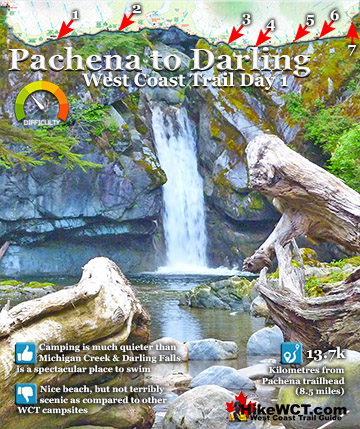



Explore BC Hiking Destinations!

The West Coast Trail

Victoria Hiking Trails

Clayoquot Hiking Trails

Whistler Hiking Trails

Squamish Hiking Trails

Vancouver Hiking Trails


